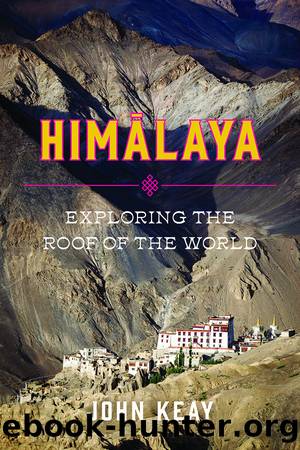Himalaya by John Keay

Author:John Keay
Language: eng
Format: epub
Publisher: Bloomsbury Publishing
So David-Néel never got to complete her circuit of Kawa Karpo. Nonetheless, and possibly as a result of some confusion between the two mountains, her biographers (and hence Wikipedia) credit her with performing the kora of that other sacred massif along the Sino-Tibetan borderland, Amné Machin. Of this shy and much misunderstood cluster of peaks she certainly knew and makes mention. Geographers somewhat optimistically consider Amné Machin a distant continuation of the Kun Lun range. Before her 1923â4 journey to Lhasa she and Yongden had explored the possibility of tracking that range west into the Tibetan heartland, and in 1938 they had again been probing this Qinghai approach when war obliged them to take cover in Dartsedo. On neither occasion is there any evidence that they undertook a kora of Amné Machin; on either or both trips, though, they may well have caught sight of the mountain.
If so, they were not the first. Two years before David-Néel had first set off for Lhasa, a lame British general with the unlikely name of George Edward Pereira had confided to his diary of sporting rambles in China (mostly in search of what he called âpandarsâ) the news of âsomething of extraordinary geographical interest â the great mountain Amné Machinâ. Sadly Pereira had died on his next Chinese marathon, leaving publication of his travels to a friend and admirer. This happened to be Colonel Sir Francis Younghusband; and thus, in a nice twist of irony, it fell to the erstwhile leader of the British invasion of Lhasa and now chairman of the committee tasked with organising the conquest of Mount Everest to explain the âextraordinary geographical interestâ of Pereiraâs Amné Machin.
The mountain was interesting not just for geographical reasons. It must have been the most heavily guarded pilgrimage peak in all Tibet. Greasy-haired warriors of impressive physique patrolled its approaches, and once a year they and their far-flung brethren converged on the mountain in their tens of thousands. Mostly mounted and bristling with firearms, they looked more like Tibetan braves than Tibetan pilgrims; they were locals in so far as their nomadic habits allowed; and despite a preference for the Panchen Lama over the Dalai Lama, they were devout Buddhists. But as Goloks (Ngologs) they belonged to a fraternity of displaced clans united only in their bloodily attested reputation for inveterate brigandage and gratuitous butchery.
Foreigners invariably fled from Golok attentions. Even fellow Tibetans were in awe of their ferocious reputation. In the early twentieth century Chinese attempts to avenge Golok outrages occasioned a succession of âGolok warsâ, and to this day Golok sensitivities have to be appeased by the well-signposted creation of a Golog Tibet Autonomous Prefecture. Amné Machin stands guard over it, ârising like a threatening ogre turned to ice in the middle of the land of the marauding Ngolokâ.8 It is the Golokâs mountain, and its god is the Golokâs god. It seems highly unlikely that Alexandra David-Néel ever risked an encounter with such trigger-happy banditti, let alone a clamber round the mountainâs sacred kora in their company.
Download
This site does not store any files on its server. We only index and link to content provided by other sites. Please contact the content providers to delete copyright contents if any and email us, we'll remove relevant links or contents immediately.
| Central Asia | Southeast Asia |
| China | Hong Kong |
| India | Japan |
| Korea | Pakistan |
| Philippines | Russia |
The Rape of Nanking by Iris Chang(3559)
The Sympathizer by Viet Thanh Nguyen(3552)
World without end by Ken Follett(3023)
Ants Among Elephants by Sujatha Gidla(2943)
Blood and Sand by Alex Von Tunzelmann(2629)
Japanese Design by Patricia J. Graham(2582)
City of Djinns: a year in Delhi by William Dalrymple(2154)
Inglorious Empire by Shashi Tharoor(2113)
Foreign Devils on the Silk Road: The Search for the Lost Treasures of Central Asia by Peter Hopkirk(2073)
In Order to Live: A North Korean Girl's Journey to Freedom by Yeonmi Park(2071)
Tokyo by Rob Goss(2034)
India's Ancient Past by R.S. Sharma(2003)
India's biggest cover-up by Dhar Anuj(1997)
The Great Game: On Secret Service in High Asia by Peter Hopkirk(1972)
Tokyo Geek's Guide: Manga, Anime, Gaming, Cosplay, Toys, Idols & More - The Ultimate Guide to Japan's Otaku Culture by Simone Gianni(1962)
Goodbye Madame Butterfly(1945)
The Queen of Nothing by Holly Black(1786)
Living Silence in Burma by Christina Fink(1741)
Batik by Rudolf Smend(1731)
